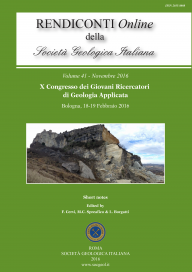
Hydrogeological monitoring to assess possible pre-seismic correlations of groundwater changes with seismic activity in central Italy
Marino Domenico Barberio (a), Andrea Billi (b), Carlo Doglioni (a), Alessandro Lacchini (a), Valentina Marinelli (a) & Marco Petitta (a)
(a) Dipartimento Scienze della Terra, Università La Sapienza, Roma, Italy. E-mail: marinodomenico.barberio@uniroma1.it
(b)Istituto di Geologia Ambientale e Geoingegneria - CNR - Roma, Italy
Volume: 41/2016
Pages: 338-341
Abstract
This paper presents the preliminary results of a multidisciplinary study to determine a possible hydrogeological survey methodology to be applied in the seismic field.
In fact in case of earthquakes, variations of the stress involving a migration of fluids occur, with consequent changes in the flow and geochemistry of groundwater. For this reason, it was identified a study site at Bussi sul Tirino (Central Italy); multiple hydrogeological and geophysical parameters including water level, temperature, electrical conductivity, crustal deformation, geochemical and isotopic composition of water are examined together to investigate possible pre-earthquake anomalous signals.
Continuous monitoring of the aquifer has been performed in the period July 2014 to March 2015 in a deep well in order to detect changes in the hydrogeological parameters due to seismic activities. The recorded data was subsequently filtered to: i) separate the typical seasonal trends of the aquifer; ii) identify the piezometric variations due to intense rainfall events; iii) distinguish the tides, "solid" or "liquid", recognized using the frequency of recorded oscillations; iv) identify changes in water level due to river-aquifer relationship. After filtering, the data have been correlated with the seismic events recorded by the national seismic network in a distance range of 30 km from the monitoring well. The comparison, for the selected time interval, shows a clear correlation between the changes in groundwater features and the seismic signal. The short time series does not allow to clarify the processes, but the obtained results are encouraging and confirm the applicability of the method in the Central Apennine region.
Keywords
Get Full Text